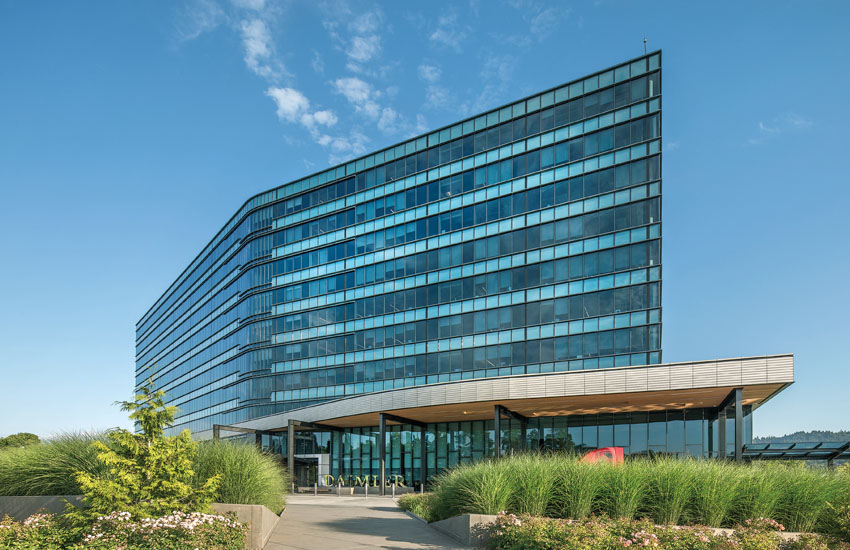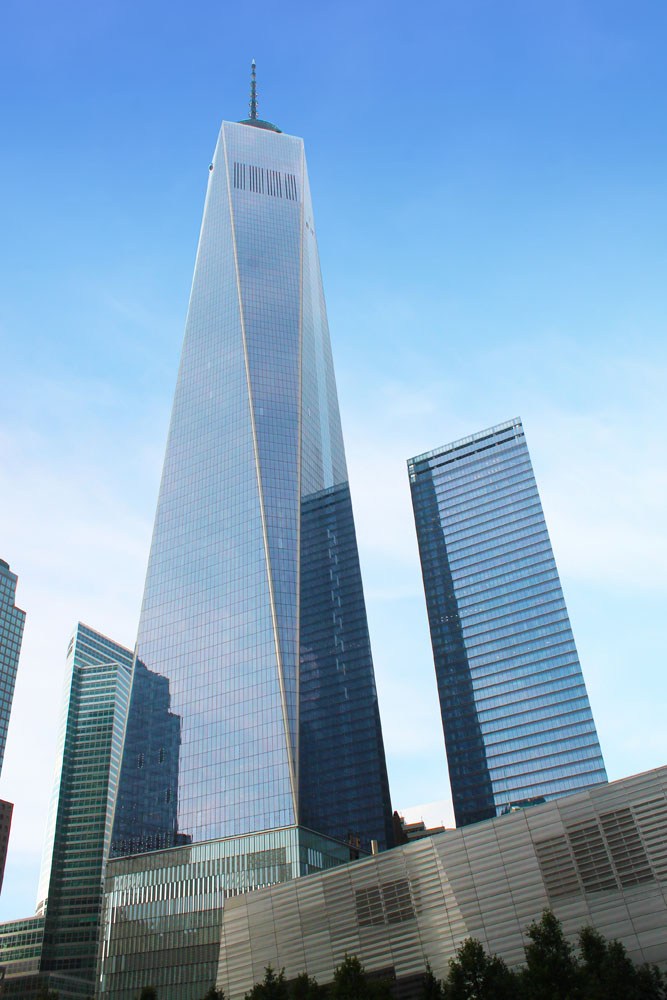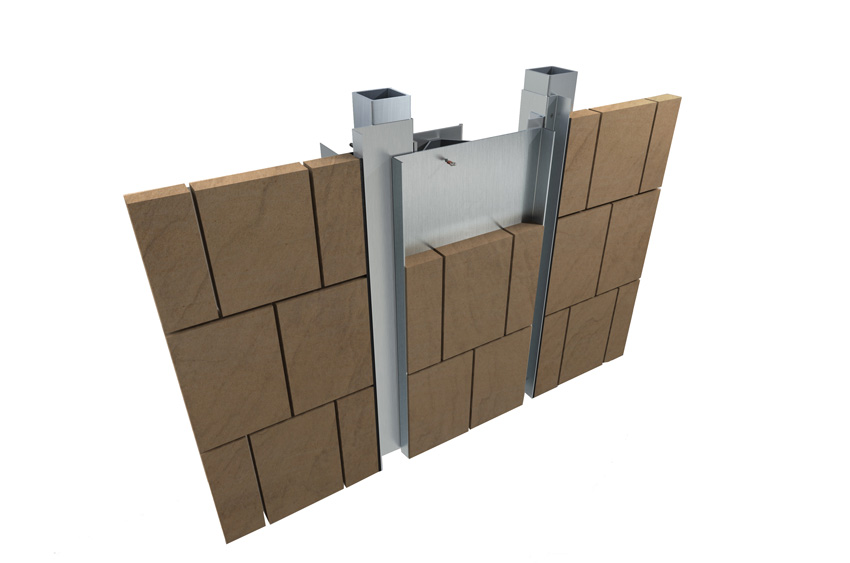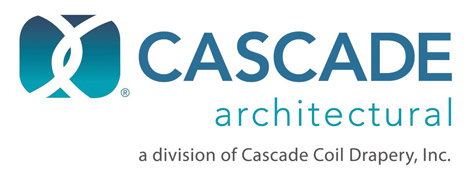Choices Abound for Attractive & Smart Facade Design
Daylighting Benefits
The overall benefit of natural light in commercial spaces cannot be understated. Reducing the amount of artificial light will not only immediately reduce the energy consumption, reducing cooling costs where a solar-control strategy is employed or reducing heating costs where a passive strategy is used.

Photo courtesy of Vitro
To optimize performance with the desired aesthetic, low-e coatings can be applied to a variety of tinted glasses ranging from blues and greens to grays and bronzes.
Another benefit of natural daylighting that is more difficult to quantify but no less important is its proven ability to increase mood and productivity for occupants. To maximize the benefits of daylighting, architects can pair low-e coatings with low-iron glass.
Nathan McKenna, segment marketing manager of Vitro Architectural Glass, has helped architects specify glass for facades and has specific advice to ensure both aesthetics and energy needs are met.
“One of the most common ways to increase daylighting today is to use large expanses of glass, sometimes called “jumbo glass.” Jumbo insulated glass units typically range in sizes from 130 inches by 204 inches up to 130 inches by 236 inches. Larger sizes can be available for special orders.” McKenna also advises on low-e to help reduce solar heat gain. “Using low-iron glass as opposed to conventional clear glass in jumbo insulated glass units can maximize light transmittance for your project while creating brilliant views to the outdoors. However, specifying jumbo glass might result not only in increased daylight but also increased solar heat gain. To improve solar control performance, optimize energy usage, and reduce reliance on artificial lighting, specify jumbo low-iron glass with low-e coatings.”
The Amazon in Seattle
The crown jewel of Amazon’s $4-billion Seattle campus is an architectural marvel. Designed by NBBJ, The Spheres comprises five floors of collaboration and relaxation spaces, as well as 40,000 plants.
A geometric shape called the pentagonal hexecontahedron forms The Spheres’ steel frame. The shape is based on one of 26 known subsets of Catalan solids named for the Belgian mathematician who first described them in 1865. The building consists of elongated pentagonal modules that appear 180 times across the three spheres. By connecting each angle of the module to a centralized hub, the architects created a fluid yet modular pattern that could be repeated throughout the building.
The Spheres’ facade contains 2,643 panes of glass. The greenhouse plants require significant amounts of daylight, so the type of glass selected for the facade was important. The glass chosen is ultra clear and energy efficient, thanks to the use of low-iron glass with solar control and low-e coatings, with a film interlayer to keep out infrared wavelengths that produce unwanted heat. NBBJ modeled more than two dozen products before selecting triangular double-laminated IGUs fabricated with a low-e coating that delivers a VLT of 74 percent and an SHGC of 0.41. The glass transmits ample daylight while rejecting heat to facilitate photosynthesis for the ecosystems within.
Keeping It Dry
The building facade can be more than just an aesthetic design choice. Most facade styles can and should be incorporated into the building envelope to help support or enhance energy savings and water-mitigation strategies. A well-designed and properly installed building envelope can help reduce energy costs, increase comfort, and support green or sustainable building goals while creating a more durable structure.

Photo courtesy of Inpro
Expansion joints on One World Trade Center in New York City help protect the interior from moisture intrusion from multiple sources.
Elements like wind and water batter a building. Temperature shifts swing from freezing to baking and back again. Whatever the facade material, it must be able to withstand the weather and contribute to the overall building envelope.
Expansion joints are a critical element of facades when materials like stone, metal plates, or glazing are specified. Expansion joints work to allow the rigid materials to safely expand and contract with temperature changes. While these devices help protect facades from cracking and thermal damage, a poorly designed or installed expansion joint can be a major point of failure in the building envelope. Moisture, specifically, becomes a significant issue with expansion joints because these buffers between facade materials are easy access points that often disrupt the continuous building envelope. Because expansion joints can stretch the entire height of the facade, the potential for moisture intrusion across the entire structure becomes a possibility. Moisture can include temperature-induced condensation, fog, drizzle, light-to-moderate rain, and wind-driven rain (thunderstorms, hurricanes, and typhoons.)
Over the past decade or more, there have been increasing instances of dramatic, extreme weather. Certainly, one of the largest and worst examples would be the flooding in Houston during Hurricane Harvey in August 2017. After landfall on August 25, that weather system “hovered” over Houston and southeastern Texas, spanning almost seven days and producing more than 50 inches of rain in some areas. Another would be Ellicott City in suburban Baltimore, which had two 500-year floods in three years.
In Northern regions, for four to five months of the year, moisture means snow. There can be melt that happens as snow comes in contact with a warmer surface, and that water in turn seeks to find its way. In addition, when expansion joints are involved, the weight of snow load is an engineering factor that must be dialed in to the design. Another cold-weather risk is ice damming: water freezing in roofing drainage channels, building up, and forcing liquid water to flow under and around flashings.
Reducing Seismic Risk
Seismic disasters, specifically earthquakes, can take a huge toll on the built environment. The primary damage of earthquakes comes from ground shaking and has many different contributing factors, such as the strength and magnitude of the quake, how close a structure is to the fault, the local geology, and even the soil type. Ground shaking impacts buildings by moving them both laterally and vertically, which can cause the structures to fail from excessive deflection and deformation.

Image courtesy of Inpro
Modern expansion-joint systems employ covers that will completely conceal the joint hardware while still providing for facade movement in a controlled manner.
Current building codes for seismic resilience are designed to protect lives by specifying that buildings stay intact long enough for occupants to safely escape. Specialty architectural products are at the core of resilient building design. Most of these products tend not to be high-profile from an aesthetic sense and may initially be seen as minor design features, but the role they play in keeping buildings safe and secure for occupants can be significant. Expansion joints are structural gaps designed to accommodate the movement of a building in a controlled manner, thus protecting the internal and external finishes from potential damage. Movement may come from one of several different sources, but seismic activity is of serious concern, especially in earthquake-prone areas.
Expansion-joint covers are designed to cover the gap of the expansion joint with minimal interruption to a building’s aesthetics and engineered to accommodate the building’s movement. In seismic zones, expansion joints are implemented to allow the building to move with little to no damage during a seismic event. These systems are critical for the safe and functional egress of a building’s occupants and ingress for first responders during and after an event.
Expansion-joint covers provide a covered transition across the expansion-joint opening and are not affected by movement along the surfaces of either side of the joint. Expansion-joint covers are a standard component for all large-plan buildings.
From a practical standpoint, it is important to specify the correct expansion-joint cover model based on nominal, maximum, and minimum joint size opening, which is typically determined by an engineer. Loading is also a critical component to ensuring the system functions correctly on a day-to-day basis. If these two factors (size and loading) are not correct in the specification, the expansion-joint cover may not be installed correctly and will not function properly as needed.
Covering the Bases
While the design of a facade will continue to be, as Morgan suggested, the visual voice for the building, there is more to this conversation than just aesthetics. Ensuring that the project is protected from the elements and potential damage from seismic events also plays a key role in creating a durable and comfortable building. With the ever-expanding list of options available to architects when it comes time to design the optimal facade, it is critical that the basics of building science be employed. Satisfying the client’s desire for beauty must be matched with responsible, durable, and energy-efficient technologies. The good news for architects is that these options are getting easier to both discover and specify.
Andrew A. Hunt is vice president of Confluence Communications and has been a writer and consultant in the green building and building science industry for more than a decade. He has authored more than 100 continuing education and technical publications as part of a nationwide practice. www.confluencec.com
Notice

www.azonintl.com

www.cascade-architectural.com

www.inpro.com

www.vitroglazings.com/solarban












